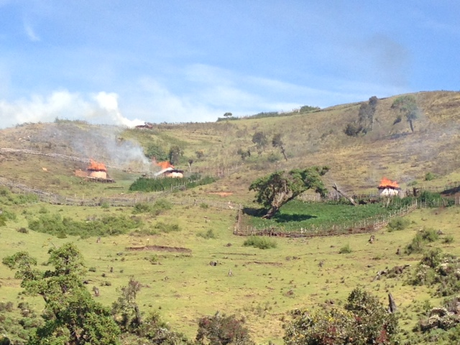
Sengwer evictions in Kenya, village destroyed / Photo courtesty Justin Kenrick / Survival
by Chris Lang / REDD-Monitor
The World Bank’s inspection panel has found that the Bank violated its safeguards in a conservation project in the Cherangany Hills in Kenya. Thousands of Sengwer indigenous people have been evicted and their homes burned down.
In January 2013, the Sengwer made a complaint to the World Bank about the Bank-funded Natural Resource Management Project (NRMP). A copy of the Inspection Panel’s May 2014 report was leaked to the Guardian. The report accuses the Bank of failing to protect the rights of the Sengwer.
World Bank-funded evictions
Under the project, the border of the Cherangany forest reserves was moved. As a result, Sengwer families found themselves living inside the forest reserve and subject to eviction. They were not consulted about the border changes.
The Kenya Forest Service carried out evictions in the Cherangany forest in 2007, 2008, 2009, 2010, 2011 and 2013. These evictions, involving burning homes and food stores, were effectively funded by the World Bank, as Forest Peoples Programme notes.
According to the Financing Agreement between the Bank and Kenya, the project was originally supposed to enhance,
“institutional capacity to manage water and forest resources, reduce the incidence and severity of water shocks such as drought, floods and water shortage in river catchments and improve the livelihoods of communities participating in the co-management of water and forest resources.”
Project failed to address land issues
The project was supposed to support the resolution of land issues, among other things through participatory boundary demarcation, and clarification of land claims.
Once the project started, Bank Management realised that resolving land issues was “far too ambitious” and could not be achieved within the time frame of the project.
In June 2011, the project was restructured. The Bank’s management acknowledged that the Project “would not be able to implement the land related commitments”, such as providing land titles for communities.
Forest Peoples Programme points out that, by failing to address the land claims of indigenous communities,
[T]he NRMP increased the marginalisation and insecurity of the traditional inhabitants of Embobut Forest, most obviously by further funding and entrenching an approach to conservation which seeks to exclude those who have traditionally cared for their forest and instead offer (poorly implemented) livelihood projects outside the forest as if this could compensate the Sengwer who stand to lose everything through this approach to conservation that is based on eviction from their ancestral forest lands.
Jim Kim “alarmed” at evictions
In January 2014, James Anaya, the UN special rapporteur on the rights of indigenous peoples condemned the evictions. “Indigenous peoples shall not be forcibly relocated from their lands or territories,” he said.
The following month, World Bank President Jim Yong Kim put out a statement saying he was “alarmed” at the latest round of evictions.
An Avaaz petition collected almost one million signatures demanding that the Kenya Forest Service stop the evictions and that the World Bank prevents such abuses in future.
Management ignores recommendations
The inspection panel’s report found several breaches of Bank safeguards. But Bank management decided to ignore most of the recommendations.
A spokesperson for Forest Peoples Programme told the Guardian:
“Unfortunately, the World Bank’s own leaked management response to the report denies many of the findings, evidently sees little importance in the fact that violation of safeguard policies has occurred, and presents an inadequate action plan to be considered by the bank’s board. It simply proposes more training for forest service staff, and a meeting to examine what can be learnt.”
Board decision today
The World Bank’s board is meeting in Washington today and will make a final decision on the Bank’s response to the inspection panel’s report. If the Bank endorses the action plan presented by management, the evictions of the indigenous peoples living in the Cherangany Hills will be completed.
More than half of the people evicted are thought to have returned to the homes since the last round of evictions.
As Connor Cavanagh, a researcher at the Norwegian University of Life Sciences, notes, the Cherangany Hills are one of five “water towers” in the country, where Kenya’s main rivers originate. The Bank’s decision in Washington could also affect thousands of people living in Mount Elgon, Mount Kenya, the Aberdares Range, and the Mau Forest complex.
Today’s decision by the World Bank’s board will tell us whether the Bank cares about violations of its safeguards, whether it supports indigenous peoples’ rights, or whether the Bank continues to promote an outmoded version of fortress conservation that tramples on human rights.

